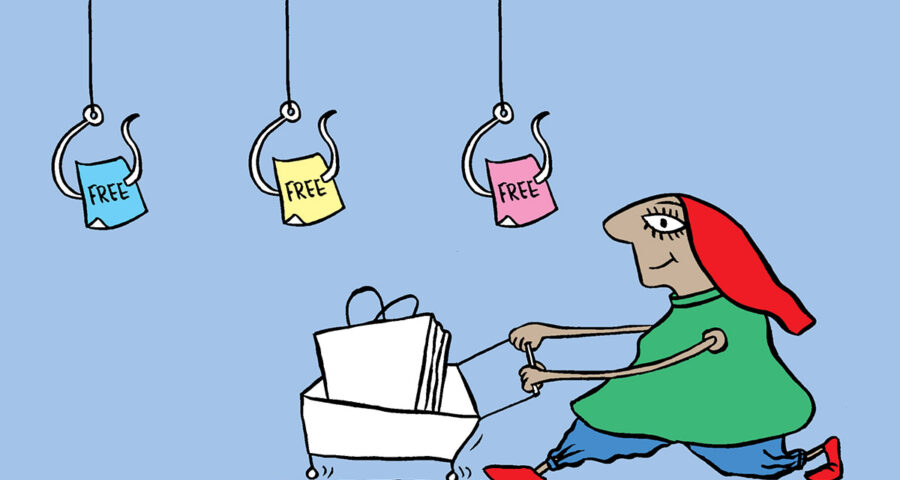During a sale, many store windows invite the shopper with impossible-to-miss visuals announcing ‘50% Discount’.
Only upon entering does the shopper realises that the one rack which fulfils this promise sells items she’d never purchase.
Umang Jain, a Delhi-based entrepreneur, while heading back home late one night, dropped in at a 24×7 pharmacy to buy a few medicines.
At the checkout, he spotted some OTC (over-the-counter) vitamins not on his prescription. He says he bought some for Rs 200.
Rajesh Gandhi, a Delhi-based businessman and his wife were done shopping when a sign at the superstore’s billing counter caught the latter’s attention: ‘Free jute bag on purchases above Rs 1,000’.
Since she was Rs 125 short, she picked up lipsticks, chocolates and key chains lying on the checkout table — for a carry bag worth Rs 15.
Gandhi says much of the extra stuff was never used.
According to Arvind Singhal, chairman, Technopak Advisors, “Baits do have an impact. While many shoppers intend to stick to their shopping lists, a promo in a different category could play on their psychology and arouse enough curiosity for them to explore and make unplanned purchases.”
Here are some of the newer tricks retailers use.
Gruen transfer (GT): It involves serpentine walkthroughs and other features aimed at making you lose track of your original shopping intent and buy impulsively, explains Rajiv Bhakat, principal and co-founder, Studio CoDe.
Malls like Select City Walk (Saket) and Ambience (Vasant Kunj) in Delhi NCR, Bhakat says, employ GT.
Besides serpentine walkthroughs, several other features — lights, music, aromas, kiddies corner, festoons, fancy restaurants and even temperature control — do the salesmanship instead of a human.
“While many people consciously visit a mall for the overall experience of shopping, eating and entertainment, focused individuals can dodge GT by having a large meal before heading to a multiplex, thereby lessening the impact of multiple aromas reinforced by large backlit images of sumptuous dishes all along the cinema exit corridor,” says retail entrepreneur and consultant Sandeep Chauhan.
Product placement: Retailers usually place the more expensive, attractively-packaged items in the front row, at eye level. Less expensive items of daily needs are placed behind or below them.
Says Sandeep Goyal, managing director, Rediffusion: “It’s a traditional retail strategy: ‘Jo dikhta hai wo bikta hai‘ (If it can be seen, it’ll sell). It’s up to the consumer to succumb to, or dodge, the temptation.”
Adds Chauhan: “Product placement has become a science today, with professional agencies using artificial intelligence to figure out the best position for a particular product to move it off the rack fastest.”
Play of words: During a sale, many store windows invite the shopper with impossible-to-miss visuals announcing ‘50% Discount’.
Only upon entering does the shopper realises that the one rack which fulfils this promise sells items she’d never purchase.
Says Chauhan: “The bait works as she then invariably inspects merchandise with lower discounts. She might even be coaxed into ‘just a trial’ from the fresh stock counter, receive effusive praise from the salesman for an excellent choice, and end up purchasing an item which, forget about being on sale, is in fact at a premium.”
Checkout counter: This is usually located at one end of the store, giving the buyer more time to look around and buy impulsively, says Chauhan.
Digital marketing executive Anshul Anand bought a pen for Rs 150 because ‘it was cute’. But she admits she rarely uses it.
As for the carry-bag trick described above, consumer lawyer Jehangir Gai says consumer courts have made it illegal for malls to charge for branded bags.
“By charging you for one, the retailer is actually making you, the consumer, pay for the advertisement,” he says.
Supersized carts: Some retailers exploit the psyche of shoppers who derive a greater sense of satisfaction from a fuller cart.
These shoppers over-purchase to avoid looking foolish pushing a huge trolley with just a few items. If there is a choice, pick an appropriate-sized cart or a hand-held basket.
In the final analysis, all a shopper can do is be aware of these subliminal cues. Leave your home with a list of items you need and try to stick to it.
Even if you succeed 80 per cent of the times, consider yourself a winner on a turf where the odds are stacked against you.
Feature Presentation: Ashish Narsale/Rediff.com
Source: Read Full Article

